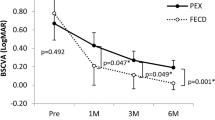Abstract
Purpose
To describe a characteristic form of the corona sign and its clinical relevance to the degree of corneal endothelial decompensation and investigate the underlying mechanism using a rabbit model.
Methods
These observational cases include 31 patients undergoing penetrating keratoplasty (PKP) and 15 patients undergoing Descemet stripping automated endothelial keratoplasty (DSAEK) with special attention to the circumferentially developed corneal epithelial edema. We also conducted a laboratory observation of horizontal water flow in the rabbit cornea.
Results
We consistently observed the corona sign at the superior periphery during the initial stage of corneal endothelial decompensation after PKP. With progressive corneal endothelial cellular loss, the epithelial edema gradually expanded circumferentially in the periphery. The endothelial cellular density associated with the corona sign significantly (P < 0.01) decreased compared with that without the sign. The endothelial cellular density decreased significantly (P < 0.05) in cases with a circumferential corona sign compared with a superior corona sign. After DSAEK, however, the corneal epithelial edema subsided from the center but persisted peripherally as a corona sign in all cases. By 3 months postoperatively, the epithelial edema was confined to the superior periphery along with uneventful corneal endothelial healing. Rabbit experiments showed that total corneal endothelial decompensation decreased the horizontal intracorneal water migration (Inoue–Ohashi phenomenon) in the corneal periphery and induced peripheral corneal edema.
Conclusions
The slit-lamp microscopic findings of the corona-like epithelial edema in the peripheral cornea are associated with the stage of corneal endothelial function. To support this, the developmental mechanism of the corona sign was demonstrated experimentally.




Similar content being viewed by others
References
Goldman JN, Benedek GB. The relationship between morphology and transparency in the nonswelling corneal stroma of the shark. Investig Ophthalmol Vis Sci. 1967;6:574–600.
Klyce SD. Corneal physiology In: The cornea. Philadelphia, PA: Lippincott Williams & Wilkins; 2005. p. 37–58
Klyce SD, Russell SR. Numerical solution of coupled transport equations applied to corneal hydration dynamics. J Physiol. 1979;292:107–34.
Dohlman CH, Hedbys BO, Mishima S. The swelling pressure of the corneal stroma. Investig Ophthalmol Vis Sci. 1962;1:158–62.
Fatt I, Goldstick TK. Dynamics of water transport in swelling membranes. J Colloid Sci. 1965;20:962–89.
Hedbys BO, Dohlman CH. A new method for the determination of the swelling pressure of the corneal stroma in vitro. Exp Eye Res. 1963;2:122–9.
Maurice DM. The permeability to sodium ions of the living rabbit’s cornea. J Physiol. 1951;112:367–91.
Mishima S, Hedbys BO. The permeability of the corneal epithelium and endothelium to water. Exp Eye Res. 1967;6:10–32.
Harris JE, Nordquist LT. The hydration of the cornea: I. The transport of water from the cornea. Am J Ophthalmol. 1955;40:100–10.
Hodson S, Miller F. The bicarbonate ion pump in the endothelium which regulates the hydration of rabbit cornea. J Physiol. 1976;263:563–77.
Manchester PT Jr. Hydration of the cornea. Trans Am Ophthalmol Soc. 1970;68:425–61.
Ytteborg J, Dohlman CH. Corneal edema and intraocular pressure: II. Clinical results. Arch Ophthalmol. 1965;74:477–84.
Maurice DM. The location of the fluid pump in the cornea. J Physiol. 1972;221:43–54.
Dohlman CH. Physiology of the cornea: corneal edema. In: The cornea. Scientific Foundations and Clinical Practice. Boston/Toronto: Little, Brown and Company; 1983. P. 3–17
Yeh PC, Colby K. Corneal endothelial dystrophies. In: The cornea. Philadelphia, PA: Lippincott Williams & Wilkins; 2005. p. 849–73
Kandori M, Inoue T, Takamatsu F, Kojima Y, Hori Y, Maeda N, et al. Prevalence and features of keratitis with quantitative polymerase chain reaction positive for cytomegalovirus. Ophthalmology. 2010;117:216–22.
Brown SI, McLean JM. Peripheral corneal edema after cataract extraction. A new clinical entity. Trans Am Acad Ophthalmol Otolaryngol. 1969;73:465–70.
Reed JW, Cain LR, Weaver RG, Oberfeld SM. Clinical and pathologic findings of aphakic peripheral corneal edema: Brown–McLean syndrome. Cornea. 1992;11:577–83.
Gothard TW, Hardten DR, Lane SS, Doughman DJ, Krachmer JH, Holland EJ. Clinical findings in Brown–McLean syndrome. Am J Ophthalmol. 1993;115:729–37.
Inoue T, Kobayashi T, Nakao S, Hara Y, Suzuki T, Hayashi Y, et al. Horizontal intracorneal swirling water migration indicative of corneal endothelial function. Investig Ophthalmol Vis Sci. 2014;55:8006–14.
Lass JH, Benetz BA, Gal RL, Kolman C, Raghinaru D, Dontchev M, et al. Donor age and factors related to endothelial cell loss 10 years after penetrating keratoplasty: specular microscopy ancillary study. Ophthalmology. 2013;120:2428–35.
Kobayashi A, Yokogawa H, Sugiyama K. Non-Descemet stripping automated endothelial keratoplasty for endothelial dysfunction secondary to argon laser iridotomy. Am J Ophthalmol. 2008;146:543–9.
Chan T, Payar S, Holden BA. Corneal thickness profiles in rabbits using an ultrasonic pachometer. Investig Ophthalmol Vis Sci. 1983;24:1408–10.
Sugar A. Brown–McLean syndrome occurring in a corneal graft. Cornea. 1997;16:493–4.
Maurice DM. Chapter I. The cornea and sclera. In: Davson H, editor. The Eye. 3rd ed. New York: Academic Press; 1984. p. 1–158.
Acknowledgments
The authors would like to thank Medical International for the English language review.
Author information
Authors and Affiliations
Corresponding author
Ethics declarations
Conflicts of interest
T. Inoue None; Y. Hara None; T. Kobayashi None; X. Zheng None; T. Suzuki None; A. Shiraishi None; Y. Ohashi None.
About this article
Cite this article
Inoue, T., Hara, Y., Kobayashi, T. et al. Corona sign: manifestation of peripheral corneal epithelial edema as a possible marker of the progression of corneal endothelial dysfunction. Jpn J Ophthalmol 60, 349–356 (2016). https://doi.org/10.1007/s10384-016-0459-8
Received:
Accepted:
Published:
Issue Date:
DOI: https://doi.org/10.1007/s10384-016-0459-8




